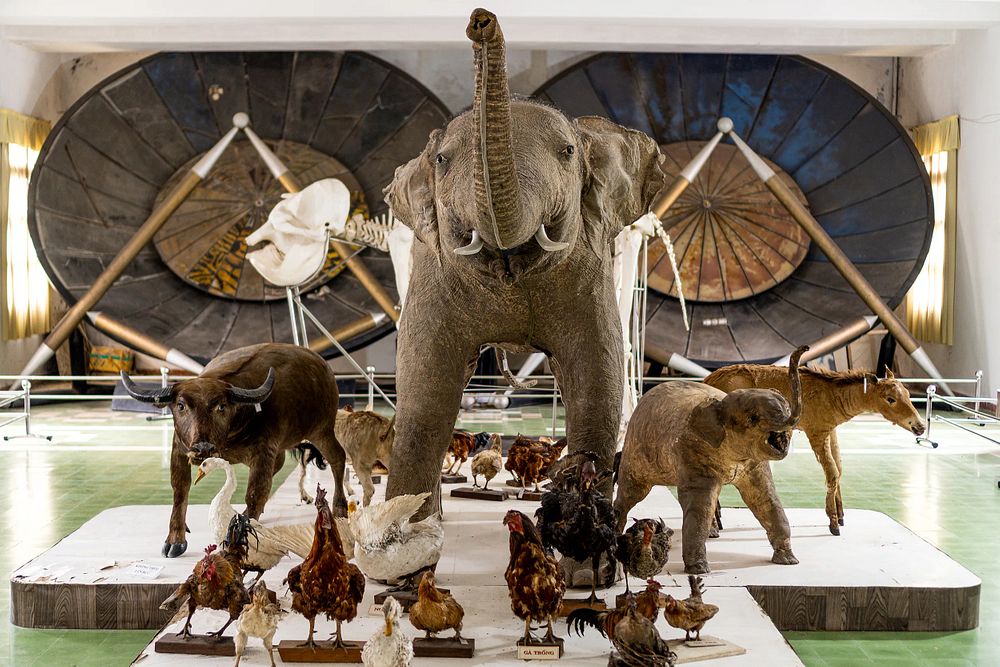Skeletons and carcasses are often reminiscent of eerie, spine-chilling scenes in horror movies. But in the taxidermy community, animal corpses are of great value for artisans to create unique works that blur the line between life and death.
Taxidermy of plants and animals mainly serve the purpose of scientific research and are often kept in museum. Sometimes, these specimens are purchased and displayed in home collections. Taxidermy mounts come in a variety of forms, sometimes they are just skeletons or internal structures, other times the specimens are preserved and displayed in a way that is almost identical to the living version.

In Vietnam, most taxidermy mounts are displayed in museums. This photo shows a collection of taxidermied animals at The Đà Lạt Biological Museum. Photo by Mike Tatarski.
Taxidermy remains quite an unconventional job and hobby in Vietnam, partly because these mounts are rarely seen outside of museums and scientific projects. On social media, a Facebook group for taxidermy aficionados has more than 7,000 members, but you can count the number of professional taxidermists on one hand.
Currently, Vietnam does not have a formal school that teaches this art. Beginners must depend on the guidance of predecessors; artisans who wish to take this skill to another level must find ways to self-educate. Nonetheless, the niched practice continues to attract many participants for its unique and intriguing process. To “unravel” the mystery of this practice, Saigoneer had the chance to talk to Quang Hiếu and Thanh Hoa, two young artists who are pursuing their passion of taxidermy.

Quang Hiếu and his skeletal articulations.
Quang Hiếu, a 22-year-old taxidermist and bone articulator, has long been captivated by the mysterious beauty of snakes and the way these animals hunt and defend themselves. What brought him to the art of skeleton articulation was when his pet snake passed away. “When it died, I thought why not preserve its skeleton to keep as a memory,” Hiếu shares.
Upon completing his first articulation around mid-2020, Hiếu realized he had the skill and patience for this art, and thus began to explore more. After just a year, his collection has grown into a miniature animal kingdom, featuring a range of species, from domesticated animals such as dogs, cats and birds, to ones we only see through documentaries such as iguanas, turtles, octopuses, etc.
Quang Hiếu reveals that in order to make the best skeletal articulation, the artisan needs to collect the body of the animal right after it died. This is so that the animal’s carcass hasn’t yet begun to decompose, making it easier to handle during the articulating process. Quang Hiếu also clarifies that he only works with animals that die of natural causes and that he would never hurt an animal: “My friends and family all know that I do this practice, so whenever an animal dies, they would reach out to me and ask if I want it. If it's suitable then they will deliver it to me.”

A snake's skeletal structure has many small and fragile bones, which requires meticulousness and skills from the artisan.
About the intricate process, Quang Hiếu explains that he begins by extracting the skin, then the organs. Thereafter, he would use worms to “remove” all the remaining flesh off the bones. This is the stage that takes up the most time and “stinks the most,” he describes.

Skeletons of snakes have really tiny and delicate bones.
Next, he soaks the skeleton in a specialized chemical overnight, then proceeds to reassemble the skeleton structure with glue. Depending on the complexity of the skeleton, this stage can take him up to two weeks to complete. Thus, on average, Quang Hiếu spends over a month on a skeletal articulation project.
The most intense step for Hiếu is most definitely assembling the bones together. For snake and python specimens, he has to painstakingly fit each rib back into the backbone, which requires extreme meticulousness and patience. With small and fragile bones, a little carelessness can cause the pieces to break, ruining the integrity.
“There have been many times when I’ve put so much effort into the mounts, only to witness the broken bones scattered on the table. Disappointment and discouragement is not without,” Quang Hiếu shares.


Two different skull specimens made by Hiếu.
Besides skeletal articulation, sometimes Quang Hiếu would change things up and do taxidermy. For taxidermy, the animal’s carcass is dissected to remove organs, then soaked in chemicals for preservation. The outer appearance looks almost exactly like the living version.
However, Quang Hiếu remains more intrigued with skeletal specimens because they help people better understand the internal structure of an organism. Sometimes, he even adds an extra touch of luminous paint to make the articulation product glow in the dark.
Hiếu has found himself a passion and career potential, thus, he wishes to continue with this path after graduating from RMIT University’s Digital Marketing program. Potential buyers are people who like to collect specimens, or want to preserve their pet’s remains after it dies. Quang Hiếu shares that he has sold about 50 works, the highest price was VND5 million with a profit of 15%.

A dog skull covered in luminous paint in a corner of Quang Hiếu's room.
Hoàng Thanh Hoa's journey to discover the art of taxidermy is no less interesting. In 2019, Thanh Hoa graduated from college with a degree in pre-school education. She was most likely to become a preschool teacher. But then she “accidentally" discovered an insect taxidermy community.
“At that time, I was really drawn to it, never realizing that such beautiful and colorful creatures exist in our world. I was blown away by those specimens, and began to research and learn ways to make some by myself.”

Specimens of colorful butterflies are nicely preserved by Thanh Hoa.
Thanh Hoa says her favorite specimens are beetles and butterflies because “they are not only beautiful but are also mystical and very ‘cool.’” Thanh Hoa also experiments with the more exotic insects such as scorpions and spiders. Many of her works are purchased by local schools for the purpose of education, especially in Biology courses. She lists her specimens for VND180,000–2 million each.

Thanh Hoa often sells her work to local schools to use in biology class.
To make a specimen, she first scouts and buys pretty and healthy insects from various sources. Then, she treats the specimen with chemicals to avoid termites and also to help maintain its shape and color. Next, Thanh Hoa shapes and pins the specimen as desired, allows it to dry, then removes it from the mold to display.
The young artisan shares with Saigoneer: “There are many insects that are extremely small and fragile; their color easily fades and their antennae and legs can easily break if not handled properly. Therefore, my work requires a lot more care than taxiderming other animals.”
Out of all the stages, Thanh Hoa believes that the processing stage and the pinning stages are the hardest; they require the most meticulousness and care. “Sometimes, with small specimens like bees, it would take me a while to pin them in place. When first started, I messed up nearly a dozen samples before gaining solid experiences.”

A bug specimen by Thanh Hoa.
For those who want to explore this art, Quang Hiếu advises: “The first thing you need is patience, lots of patience. You will also have to get used to the pungent smell of dead animals, and you will also need a bit of dexterity.”
Thanh Hoa also agrees that patience is the crucial quality that all taxidermists need. "In addition, people in this profession also need solid knowledge on the organisms that they are working with, otherwise it will not be possible to produce something as beautiful as the original living creature."

Taxidermy helps preserve the beauty of these animals even when their life is gone.
In the meantime, both Quang Hiếu and Thanh Hoa are working on new plans for their passion and career. While Hiếu wants to expand his social media network and dream of a small exhibition in the future, Thanh Hoa will show off a new miniature design incorporating bugs and butterflies. Even though they are facing certain obstacles and limitations because of the pandemic, they continue to work hard, keeping themselves busy with bones, skulls, organs, skin layers, etc., to make their designs perfect.
[Photos courtesy of Hiếu and Hoa]
This article was originally published in 2021.
















